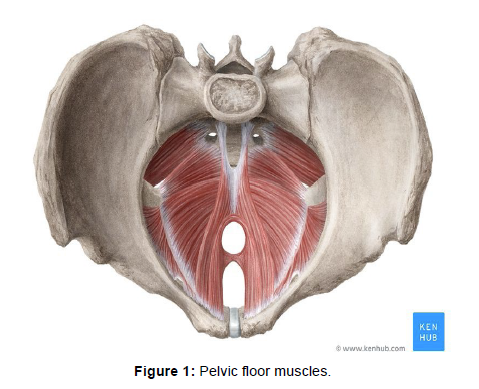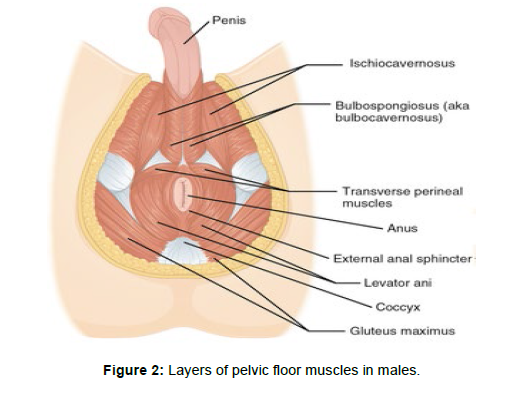Role of Physiotherapy in Constipation Caused due to Pelvic Floor Dysfunction in Males
Received: 20-Sep-2022 / Manuscript No. jnp-22-73092 / Editor assigned: 22-Sep-2022 / PreQC No. jnp-22-73092 (PQ) / Reviewed: 06-Oct-2022 / QC No. jnp-22-73092 / Revised: 12-Oct-2022 / Manuscript No. jnp-22-73092 (R) / Accepted Date: 18-Oct-2022 / Published Date: 19-Oct-2022 DOI: 10.4172/2165-7025.1000546
Abstract
The muscles of pelvic floor cover the bottom of the pelvis and support the pelvic organs-bladder and bowel, and uterus in women. When there is weakness of pelvic floor muscles, bladder and bowel control can be affected. The pelvic floor muscles help to control the release of urine faeces and flatus and to delay emptying until it is convenient. The contraction of these muscles, help in lifting the internal organs of the pelvis and tighten the openings of the vagina, urethra and anus. Whereas, when these muscles of pelvic floor are relaxed, they allow the passage of urine and faeces. This function is especially vital if the urethral or anal sphincters (muscles) are not working normally as in many cases of pregnancy or prostate surgery. The pelvic floor muscles in women provide support to the baby during pregnancy and need to be relaxed during the labour. The pelvic floor muscles support bladder and bowel in males. The urethra from the bladder and the rectum from the bowel pass through the pelvic floor. The strong pelvic floor muscles prevent the leaking of urine and faeces. The pelvic floor muscles also help with sexual sensation and function. Many a times, the pelvic floor dysfunction goes unnoticed and the patient keeps wondering about the reasons for constipation and seeks advice from the gastroenterologists and Physicians. The dysfunction goes undiagnosed and later the patient is left with dependency on medications. The role of Physiotherapy plays a vital role in treatment of pelvic floor dysfunction in males and its subsequent disorders such as constipation, urinary continence, bloating etc.
Introduction
The pelvic floor muscles are located between the coccyx and the pubic bone. They support the uterus, vagina and bladder and bowel, as well. Sphincters are the muscular bands which encircle the urethra, vagina and anus while passing through the pelvic floor. When the pelvic floor muscles contract, the internal organs are lifted and the sphincters tighten the openings of the anus, vagina and urethra. Relaxing up of the pelvic floor can allow for easy passage of faeces and urine (Figure 1).
The male pelvic floor is a complex structure comprising of muscles, ligaments, fascia and nerves. The pelvic floor muscles form a part of pelvic floor and play an important role in sexual function as well as they maintain urinary and faecal continence. The male pelvic floor muscles form a dome-shaped structure in the pelvis which is similar to a hammock. They are responsible for the maintenance of continence, sexual function and support of pelvic organs [1,2]. The pelvic floor muscles have 3 layers and have a complex relationship with the surrounding bony pelvis, fascia, ligaments and nerves.
The superficial perineal pouch is the most superficial layer made up of bulbospongiosus, ischiocavernosus, superficial transverse perineal and external anal sphincter. This layer of muscles is mainly involved in ejaculation and urinary and faecal continence, as well [3]. The urogenital diaphragm is the second layer, made up of the deep transverse perineals, the sphincter urethrae and the compressor urethrae. This layer is mainly responsible for urinary continence when there is increased intraabdominal pressure, caused due to coughing or sneezing. The deepest layer is the pelvic diaphragm, the muscles that comprise of pubococcygeus, puborectalis, pubourethralis, iliococcygeus and ischiococcygeus. These muscles are mainly responsible for the support of pelvic organs and maintenance of continence (Figure 2).
If the pelvic floor muscles do not function well, the internal organs will lack full support. This may affect the control of passage of urine, faeces or wind. The common causes of a weak pelvic floor include pregnancy, childbirth, prostate cancer treatment in males, obesity and the associated straining during chronic constipation.
Symptoms of pelvic floor muscle dysfunction: The symptoms of a pelvic floor dysfunction include
• leaking urine while coughing, sneezing, laughing or running
• passing off the wind from either the anus or vagina when bending over or lifting
• decreased sensation in the vagina
• a noticeable bulge at the vaginal opening
• a heaviness or dragging in the pelvis or back
• recurrent urinary tract infections
Causes of pelvic floor muscle dysfunction: The pelvic floor muscles can be weakened by
• supporting the weight of the uterus during pregnancy
• vaginal childbirth, which may overstretch the muscles
• the pressure caused to due obesity
• chronic constipation and thus straining to defecate
• constant and prolonged coughing
• some forms of surgery that require cutting of the muscles, as in prostate cancer treatment in males.
• decreased levels of oestrogen after menopause
• pelvic floor muscle tension caused by painful periods, endometriosis.
Exercising on a regular basis helps to reduce constipation by stimulating a sluggish bowel and moving food through the intestines bit easily. The longer stay of food in the bowel leads to more water loss from stool. This makes it hard and dry, which is more difficult to pass. The aerobic exercises increase heart rate and breathing rate that further, stimulates the natural contraction of intestinal muscles which moves stools out even quicker.
Role of physiotherapy in constipation triggered by pelvic floor dysfunction
Constipation is one of the commonest gastrointestinal complaints with one-third of the general population reporting it during their lifetime. Patients give a broad range of symptoms to describe constipation, including being irregular, having hard stools, a feeling of incomplete evacuation, bloating, distention, prolonged time needed to evacuate or time between movements, as well as a need to strain or apply manual pressure. Physicians often relate constipation with infrequent bowel movements or a functional disorder, yet, less than 3% of the general population report fewer than a normal (<3 times per week) number of evacuations and testing is often needed to exclude other causes of constipation. Constipation is defined as a symptom-based disorder characterized by unsatisfactory defecation. The three primary causes of constipation, which are distinguished according to their pathophysiological characteristics, include slow transit constipation (colonoparesis), defecatory disorders (pelvic floor dysfunction, outlet obstruction), and normal transit constipation (functional). When mechanical, anatomical, and disease- and dietrelated causes of constipation have been ruled out, clinical suspicion should be raised to the possibility that PFD is causing or contributing to constipation. A focused history and digital examination are key components in diagnosing pelvic floor dysfunction [4,5].
Outlet constipation is a type of constipation that occurs when the stool is stuck in the rectum, and this is usually due to the dysfunction of the pelvic floor muscles. If the pelvic floor muscles in the rectum are too tight and are not able to relax, it becomes difficult for stool to pass through. This can lead to straining during bowel movement which causes the muscles to tighten even further [6]. The pelvic floor muscles need to relax in order for the stool to pass through the exit. If the stool feels stuck there is a tendency to strain. But the more the straining and pushing, the tighter the muscles become. The patient complaints of pain in flanks in the early morning, which is relieved after passing out the stool. This is the main clinical feature for consideration. There may be adhesions at the level of muscles around the gluteal and pubic region. Many diagnostic procedures such as CT-Scan, Colonoscopy cannot find the tightness of the pelvic floor muscles that are responsible for constipation or excessive straining during defecation.
1) Ultrasonic therapy for adhesions at muscles.
2) Soft tissue mobilization of the tight muscles.
3) Exercises for strengthening of pelvic floor muscles.
4) Kegel exercises helps to manage the incontinence and constipation by helping to strengthen pelvic floor muscles [7-9].
Conclusion
Constipation is common in the general population and the underlying aetiology is key in order to provide the appropriate therapeutic intervention. Treatment may be as simple as lifestyle modifications or the addition of fibre but may require pharmacologic approach as well. Often multiple treatment modalities are necessary to improve outcomes. The proper diagnosis and pelvic floor exercises can help relieve the symptoms. Further studies can be carried out for the reasons and likewise the treatment.
Declarations
1) Ethics approval and consent to participate-NA
2) Consent for publication-Yes
3) Availability of data and material-NA
4) Competing interests- Neurology
5) Funding- NA
6) Authors contributions-NA
Acknowledgement
I would like to thank my colleagues for their support and the blessings bestowed me by my Grandparents and Parents. I would also like to thank my husband Nitin Rodhia for his constant support.
References
- Better health Channel (2022) Pelvic floor.
- Ken Hub (2020) Pelvis and perineum.
- Continence foundation of Australia (2020) Understanding incontinence.
- Beth Israel Deaconess Medical Centre (2016) Constipation and the Pelvic Floor Muscles.
- World Gastroenterology Organisation (WGO) (2019) Global Guardian of Digestive Health. Serving the World.
- Mayo Clinic (2014) Treating patients with pelvic floor dysfunction in males.
- Memorial Sloan Kettering Cancer Center (2022) Pelvic Floor muscle exercises for men.
- Pelvic floor center (2016) Chronic constipation.
- Wallace SL, Miller LD, Mishra K (2019) Pelvic floor physical therapy in the treatment of pelvic floor dysfunction in women. Curr Opin Obstet Gyne 31: 485-493.
Citation: Khurana B, Kour MP, Kaur S, Dobhal A (2022) Role of Physiotherapy in Constipation Caused due to Pelvic Floor Dysfunction in Males. J Nov Physiother 12: 546. DOI: 10.4172/2165-7025.1000546
Copyright: © 2022 Khurana B, et al. This is an open-access article distributed under the terms of the Creative Commons Attribution License, which permits unrestricted use, distribution, and reproduction in any medium, provided the original author and source are credited.


